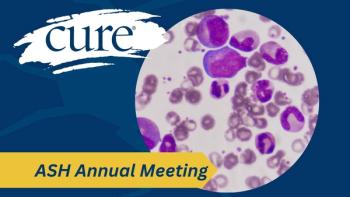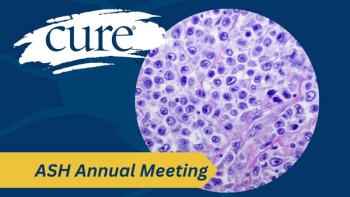
Imdelltra Shows Survival Benefit in Small Cell Lung Cancer
Key Takeaways
- Imdelltra significantly improved progression-free and overall survival compared to chemotherapy in small cell lung cancer patients, with a median overall survival of 13.6 months versus 8.3 months.
- The trial demonstrated better patient-reported outcomes and a favorable safety profile for Imdelltra, despite higher rates of cytokine release syndrome compared to chemotherapy.
Imdelltra improved survival and quality of life versus chemotherapy as second-line treatment for small cell lung cancer, reinforcing it as a new SOC.
Among patients with small cell lung cancer, second-line treatment with Imdelltra (tarlatamab-dlle) led to statistically significant and clinically meaningful improvements in progression-free survival and overall survival versus chemotherapy, according to data from the primary analysis of the phase 3 DeLLphi-304 trial presented at the
Findings showed that at a median follow-up of 11.2 months for patients treated with Imdelltra (254 patients) and 11.7 months for those given chemotherapy (255 patients), Imdelltra led to a median overall survival of 13.6 months compared with 8.3 months for chemotherapy. In the Imdelltra arm, the 6- and 12-month overall survival rates were 76% and 53%, respectively. These respective rates were 62% and 37% in the chemotherapy arm.
“Taking the efficacy and safety data together, these data clearly support Imdelltra as a preferable therapy for patients in the second-line setting for small cell lung cancer,” lead study author Dr. Charles M. Rudin said in a presentation of the data. “Beyond redefining the standard of care for these patients, this study also establishes a new paradigm for the use of bispecific, T-cell engager immunotherapies for our patients with lung cancer.”
Rudin is deputy director of the Cancer Center, co-director of the Druckenmiller Center for Lung Cancer Research, and the Sylvia Hassenfeld Chair in Lung Cancer Research at Memorial Sloan Kettering Cancer Center in New York, New York.
In May 2024, the FDA granted accelerated approval to Imdelltra for the treatment of patients with extensive-stage small cell lung cancer with disease progression on or after platinum-based chemotherapy. This regulatory decision was supported by data from the phase 2 DeLLphi-301 trial.
More Efficacy, Patient-Reported Outcomes and Safety Data
Findings also demonstrated that the median progression-free survival was 4.2 months for the Imdelltra arm versus 3.7 months for the chemotherapy arm. The 6-month progression-free survival rates in the Imdelltra and chemotherapy arms were 31% and 23%, respectively; the respective rates at 12 months were 20% and 4%.
Patients in the Imdelltra arm achieved an objective response rate of 35% compared with 20% for those given chemotherapy. In the experimental arm, the rates of complete response, partial response, stable disease, and progressive disease were 1%, 34%, 33% and 22%, respectively. In the chemotherapy arm, these respective rates were 0%, 20%, 44% and 20%. Ten percent and 16% of patients in the Imdelltra and chemotherapy arms, respectively, were not evaluable for response.
The median duration of response was 6.9 months in the Imdelltra arm compared with 5.5 months in the chemotherapy arm. The respective 6- and 12-month duration of response rates were 56% and 41% for Imdelltra compared with 29% and 13% for chemotherapy. The median time to response was 1.5 months versus 1.4 months for Imdelltra and chemotherapy, respectively. At data cutoff, response was ongoing in 47% of patients in the experimental group versus 15% of the control group.
Regarding patient-reported outcomes, the mean improvement in dyspnea score from baseline to week 18 was 1.94 in the Imdelltra arm versus –7.20 in the chemotherapy arm. At week 18, cough score improvements were reported in 16.1% of patients in the Imdelltra group versus 9% of patients in the control group. Improvements in chest pain at week 18 were reported in 8.7% and 3.5% of patients, respectively.
The median treatment duration was 4.2 months in the Imdelltra arm (252 patients) versus 2.5 months in the chemotherapy arm (244 patients). Any-grade treatment-emergent adverse effects occurred in 99% of patients in the experimental arm versus all patients in the chemotherapy arm. The rates of any-grade treatment-related adverse effects were 93% and 91%, respectively.
Grade 3 (severe) treatment-related adverse effects were reported in 27% of patients in the Imdelltra group compared with 62% of patients in the chemotherapy group. The respective rates of serious treatment-related adverse effects were 28% and 31%. These effects led to dose interruption and/or reduction in 19% of patients treated with Imdelltra versus 55% given chemotherapy, and led to treatment discontinuation in 3% and 6% of patients, respectively. One patient experienced a grade 5 (death) treatment-related adverse effect in the Imdelltra arm compared with four patients in the chemotherapy arm.
In the experimental arm, treatment-emergent cytokine release syndrome occurred during the first 2 cycles of Imdelltra in 60% of patients who were monitored for 48 hours (209 patients) at grade 1 (45%), grade 2 (13%), and grade 3 (1%). Nineteen percent of patients had serious cytokine release syndrome, and it led to treatment discontinuation in 0.5% of patients. The median time to intervention was 27 hours from the last Imdelltra dose.
In patients who were monitored for cytokine release syndrome for at least six to eight hours during the first 2 cycles of treatment with Imdelltra (43 patients), cytokine release syndrome was reported in 37% of patients at grade 1 (28%) and in 9% of patients at grade 2. Seven percent of instances in this group were serious, although none led to treatment discontinuation. The median time to intervention was 17 hours.
Although treatment-emergent adverse effects such as cytokine release syndrome, dysgeusia, fever, and decreased appetite were more common with Imdelltra, chemotherapy was associated with increased incidence of anemia, neutropenia, thrombocytopenia, and decreased platelet counts. The rates of grade 3 or higher adverse effects such as anemia, neutropenia, leukopenia, thrombocytopenia, febrile neutropenia, decreased platelet count, decreased neutrophil count, fatigue, pneumonia and low sodium levels were all higher with chemotherapy versus Imdelltra.
DeLLphi-304 Background
The open-label, randomized, controlled study enrolled patients at least 18 years of age with histologically or cytologically confirmed small cell lung cancer who experienced disease progression following a first-line, platinum-based regimen with or without an immune checkpoint inhibitor. Patients were required to have an ECOG performance status of 0 or 1. Patients with asymptomatic, previously treated or untreated brain metastases were allowed to enroll.
Investigators randomly assigned patients in a 1:1 fashion to receive Imdelltra or chemotherapy comprising lurbinectedin (47 patients), topotecan (185 patients), or amrubicin (23 patients). Stratification factors included prior treatment with a PD-(L)1 inhibitor (yes versus no), chemotherapy-free interval (less than 90 days versus at least 90 days to less than 180 days versus at least 180 days), brain metastases (yes versus no), and intended chemotherapy (topotecan/amrubicin versus lurbinectedin).
Overall survival served as the trial’s primary end point. Progression-free survival and patient-reported outcomes were key secondary end points. Other secondary objectives included objective response rate, duration of response, disease control rate and safety.
At baseline, the median age was 64 years in the Imdelltra arm versus 66 years (range, 26-84) in the chemotherapy arm. The majority of patients in both arms were male (Imdelltra, 72%; chemotherapy, 66%), were White (60%; 55%), were current or former smokers (91%; 88%), had an ECOG performance status of 1 (67%; 68%), received prior anti–PD-(L)1 therapy (71%; 71%), and received prior radiotherapy (63%; 63%). A chemotherapy-free interval of less than 90 days was most common in both arms (43%; 45%), followed by at least 90 days and less than 180 days (33%; 31%) and at least 180 days (24%; 25%).
Brain metastases were present in 44% of patients in the Imdelltra arm versus 45% of patients in the chemotherapy arm. The rates of patients with liver metastases were 33% and 37%, respectively. Among evaluable patients, 95% in the Imdelltra arm (217 patients) and 93% in the chemotherapy arm (214 patients) were positive for DLL3 expression.
Reference:
“Tarlatamab versus chemotherapy as second-line treatment for small cell lung cancer: primary analysis” by Dr. Charles M. Rudin, et al., 2025 ASCO Annual Meeting.
For more news on cancer updates, research and education, don’t forget to





